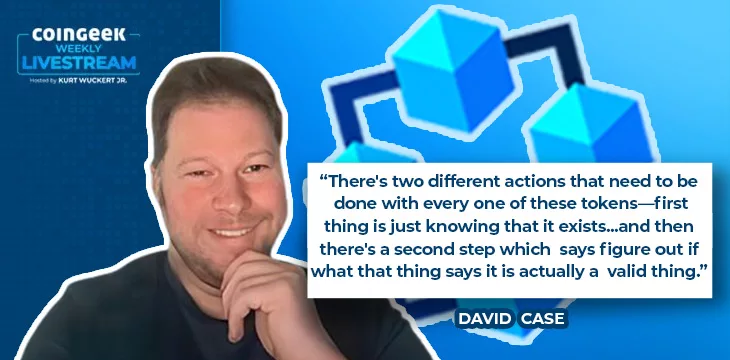
|
Getting your Trinity Audio player ready... |
On episode two of the CoinGeek Weekly Livestream, David Case joins host Kurt Wuckert Jr. to talk about tokens, indexers, overlay networks, and other questions related to Bitcoin.
Dark2Light, BSV nodes out of sync, and Wuckert’s latest article
Wuckert begins by showing his Dark2Light card game, which he recently received. He says it’s at least as fun as Cards Against Humanity, and probably more so.
He then explained what was going on with Exodus’s wallet and several others. Their nodes are out of sync, but there’s nothing fishy going on. He tells those affected to download ElectrumSV, export the private key from the wallet they’re using, import the information, and it should populate. While there are some issues related to ElectrumSV, they are dealt with through various blog posts.
To end the intro, Wuckert points readers to his latest article on CoinGeek titled The beautiful imperfections of Bitcoin. Be sure to check it out.
David Case on Ordinals, overlay networks, and indexers
Case then joins the livestream and dives straight into the deep end with an overview of Ordinals. At its base, it’s a numbering system and serial number assigned to all satoshis, he says.
Diving deeper, Case explains that, over time, individual satoshis can transfer from one transaction to another. “An Ordinal is really nothing more than an individual satoshi that you are tracking across multiple transactions,” he tells us.
Having covered the base layer, Case explains the second one: inscriptions. Going back through the history of the blockchain, we can discover all the different data that has been inscribed on a given satoshi.
“It’s building an NFT layer on top of very fundamental ways of looking at Bitcoin transactions.”
Wuckert points out that Case built an indexer and asks him to explain what it’s doing and why it’s necessary. He replies that indexers aren’t necessarily required, but they’re useful as tools that watch, identify, and label transactions before putting them in a database.
“This is the true layered approach to Bitcoin,” Wuckert says, pointing out that the Lightning Network is another system entirely. Case somewhat agrees but doesn’t want to get too pedantic.
Is this a good example of an overlay network? After explaining the different ways to view this, Case says that whether you’re dealing with an overlay network or an indexer, you’ve got some rules, you care about them, and you want to interpret what’s happening in a set of transactions so you can pick out information relevant to what you’re trying to do.
Where would we get said information? Either by looking at everything that has ever happened on the blockchain and picking things that match given criteria or by using a tool that does so, like JungleBus. A subscription to such a service can give you the data you need to index.
Overlay networks are one step removed from this, Case explains. You’re not relying on what has already been mined but rather are dealing with peer-to-peer transactions. For example, a user might want to send a token to someone else, and an overlay network can facilitate this.
BSV-20 fungible tokens
Wuckert asks Case to explain what’s happening with BSV-20s and the challenges.
Case starts by saying that while he created the spec for it, it has gone through some growing pains. It started with BRC-20 tokens, a new concept on BTC Ordinals. It allows someone to write a blob of JSON to the chain to define a token, including its supply and how many can be minted at a time. There’s also the concept of community mints; the person who wrote the data to the chain to define the token didn’t have any, so it’s fair and truly decentralized.
While this is all good, it causes some challenges for indexers as there’s nothing on-chain that points to anything else on-chain that defines what it is. Wuckert points out that this is the Back to Genesis problem in a nutshell, and Case agrees. He then explains how BSV-20 v2 solves this problem by having whoever defines a token define its entire balance. Since it’s UTXO-based, we can work backward, tracing a token back to when it was created.
After some conversation about OJBK and the challenges related to the massive numbers of tokens being minted on BSV, the pair switch to answering viewers’ questions.
To hear more about indexing the massive numbers of tokens on BSV and to hear Case answer viewer questions, check out the live stream. Don’t forget to subscribe to CoinGeek.com to get alerts about more content like this!
Watch: Tokens on Bitcoin? One Sat Ordinals and sCrypt

 11-22-2024
11-22-2024


